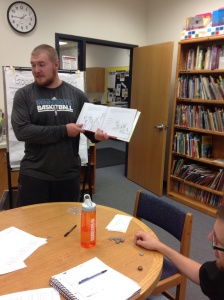This was our second lesson that we planned and taught and I felt that it went much better than our first. I felt like I was able to get a feel for teaching economic concepts during the first lesson and thrived much more in the second. Our second lesson was also on a concept that was a little bit easier to explain and also easier to monitor the activity which our students participated in.
I liked how we were able to integrate different subjects into this lesson as well. We were able to focus our lesson using a piece of children’s literature which kept the lesson on track because people wanted to know what was going to happen next. We were also able to incorporate money, counting, and subtraction through our lesson as well. One thing I would have done different in my group is to have an extra set of coins so that I could do the money part right along with my students. I liked our use of exit cards as well because they were a simple way to see if students had retained information and concepts.

I loved this book. It was a great tool for the lesson. It was interactive, had lessons beyond economics (family dynamics, good verses bad choices, cause and effect, etc.). The lesson provided kids plenty of means to process the information. They had a visual, physically moved money around, could connect to the story and potentially the inter-workings of the family, and you felt something each time you had to put some of your money away. We were rich then we lost it all! Great lesson.
This was a good review for me because I’m still not very good at making change quickly! Kids could write their own stories too as a way to extend the activity. Great lesson, taught with a lot of confidence and enthusiasm.
I really liked this lesson. It was a fun way to talk about money and like you said, adding subtraction and incorporating a children’s book. The story itself kept the students engaged. They had to listen so they knew how much money to take away. One thing that I mentioned after the lesson was doing the activity with the students. Also checking half way through to make sure all the students had the same amount/ the correct amount left. There was a part in the story when he spent a lot of his money that threw some of us off.
I like how you incorporated the book into the lesson and had us follow along by counting our own money. It was a great way to keep students engaged and thinking as you read the book. It also was a great visual representation for kids to see as the money is being spent. Good life skills to teach!